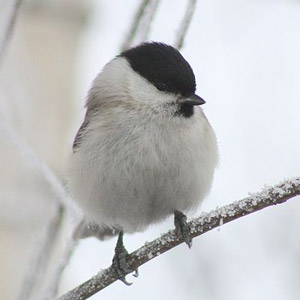Pratique | Débuter
Les rondes d’oiseaux

Les mésanges, dont les Mésanges nonnette (Poecile palustris) et boréale (Poecile montanus), sont souvent à l’origine de la formation de « rondes » de passereaux.Photographie : Estormiz / Commons Wikimedia
Introduction
Vous avez peut-être déjà observé en hiver, dans un bois ou une forêt, un bruyant cortège de passereaux volant d’arbre en arbre, généralement mené par des mésanges et incluant d’autres espèces (sittelles, grimpereaux, etc.) ? Ces rassemblements internuptiaux plurispécifiques d’oiseaux qui vagabondent à la recherche de nourriture sont appelés des « rondes ».
Ces groupes se rencontrent un peu partout dans le monde, mais ils sont particulièrement développés dans les régions tropicales, et notamment en Amérique centrale et du Sud : ils peuvent alors être composés de centaines d’oiseaux appartenant à des dizaines d’espèces.
Nous vous présentons ce comportement passionnant et encore relativement méconnu, en essayant en particulier de répondre à certaines questions : comment se forment ces groupes ? Comment sont-ils organisés ? Quels sont les buts de ces associations ? Quelles sont les espèces concernées ?
Nous remercions Arthur Grosset et François Lelièvre pour nous avoir aidés à illustrer cet article.
Abstract
You may have already seen in winter, in a wood or a forest, a noisy flock of passerines flying from tree to tree, usually led by tits or chickadees and including other species (nuthatches, creepers, …). These mixed groups occur throughout the world, but they are particularly well developed in tropical regions, especially in Central America and South America: they can then involve hundreds of birds belonging to dozens of species.
In this article, we present you of this complex behavior, trying to answer several questions: how do these groups form? How are they organized? What are the reasons for these associations? Which species are involved?
Poursuivez la lecture de cet article, en vous abonnant dès maintenant !
Découvrez les Archives d’Ornithomedia.com
Pour seulement 10,00 €TTC/an (ou 6,00 € les 6 mois)
Profitez de plusieurs centaines d’articles en accès illimité et sans aucun engagement.
Compléments
Ouvrages recommandés
- Le guide Ornitho de Killian Mullarney
- A Field Guide to the Birds of Brazil de Ber van Perlo
- A Field Guide to the Birds of Peninsular Malaysia and Singapore de Allen Jeyarajasingam et Alan Pearson
À lire sur le web
- Le site web d’Arthur Grosset : www.arthurgrosset.com
- La galerie de François Lelièvre sur Flickr : www.flickr.com/photos/fleli
Sources
- E. P. Vanderduys, A. S. Kutt, J. J. Perry et G. C. Perkins (2012). The composition of mixed-species bird flocks in northern Australian savannas. Emu 112(3) 218-226. http://www.publish.csiro.au
- Toshitaka N. Suzuki (2012). Long-Distance Calling by the Willow Tit, Poecile montanus, Facilitates Formation of Mixed-Species Foraging Flocks. Ethology. Volume 118, numéro 1, pages 10–16, janvier. http://onlinelibrary.wiley.com
- Larousse. Mésanges. thttp://www.larousse.fr
- Jullien Mathilde, Thiollay Jean-Marc (1996). Signification adaptative de la vie en groupe chez les oiseaux : le cas des passereaux forestiers néotropicaux. = Adaptative significance of mixed-species bird flocks in the Neotropics. Travaux Universitaires. Thèse nouveau doctorat. http://cat.inist.fr
- Douglass H. Morse (1970). Ecological Aspects of Some Mixed-Species Foraging Flocks of Birds. Ecological Monographs. Vol. 40, numéro 1, pages 119-168. http://www.jstor.org
- John R. Krebs (1973). Social learning and the significance of mixed-species flocks of chickadees (Parus spp.). Revue canadienne de zoologie, 51(12). Pages 1275-1288. http://www.nrcresearchpress.com
- Theodore O. Berner et Thomas C. Grubb, Jr. (1985). An Experimental Analysis of Mixed-Species Flocking in Birds of Deciduous Woodland. Ecology. Vol. 66, No. 4 (Aug., 1985), pages 1229-1236. http://www.jstor.org
- LPO Alsace. Les phénomènes remarquables à observer : rondes hivernales. http://alsace.lpo.fr
- Wikipedia. Mixed-species foraging flock. http://en.wikipedia.org/wiki/Mixed-species_foraging_flock
- Pedro Ferreira Develey et Carlos Augusto Peres (2000). Resource seasonality and the structure of mixed species bird flocks in a coastal Atlantic forest of southeastern Brazil. Journal of Tropical Ecology. Volume 16. Pages 33-53. http://journals.cambridge.org
- Olav Hogstad (2008). Social rank and antipredator behaviour of Willow Tits Parus montanus in winter flocks. Ibis. Volume 130, numéro 1, pages 45–56. http://onlinelibrary.wiley.com
- Hari Sridhar, Guy Beauchamp, Kartik Shanker (2009). Why do birds participate in mixed-species foraging flocks? A large-scale synthesis. Animal Behaviour. Volume 78, numéro 2. Pages 337–347. http://www.sciencedirect.com
- Paul G. Rodewald, Margaret C. Brittingham (2002). Habita use and behaviour of mixed species landbirds during fall migrations. The Wilson Bulletin 114(1):87-98. http://www.bioone.org
- Chao-chieh Chen, Fushing Hsieh (2002). Composition and foraging behaviour of mixed-species flocks led by the Grey-cheeked Fulvetta in Fushan Experimental Forest, Taiwan. Ibis. Volume 144, numéro 2, pages 317–330. http://onlinelibrary.wiley.com




Aucun commentaire sur ce sujet
Participer à la discussion !